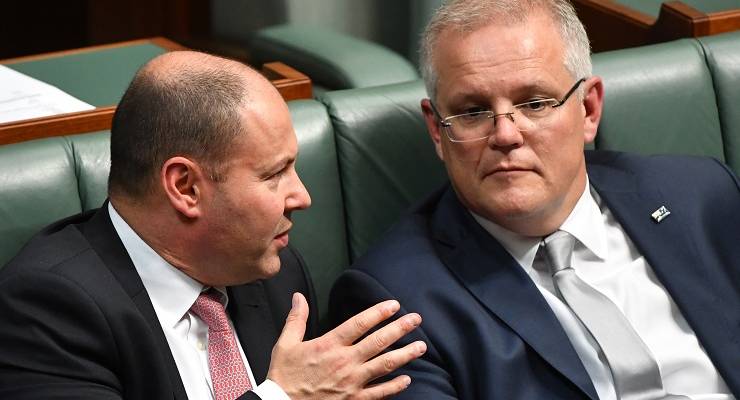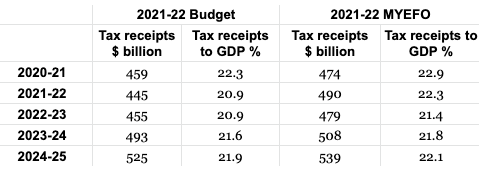
Yesterday’s Mid-Year Economic and Fiscal Outlook is one of the most extraordinary since the Howard government instituted them back in the 1990s. It’s remarkable not merely for the blatant intent of Scott Morrison and Josh Frydenberg to buy their way to election victory, but for the way it further expands the size of government in Australia far above any previous levels since World War II.
The headline budget figures were little changed from the May budget: the deficit for 2021-22 is now expected to be $99 billion, not $105 billion, and that for 2022-23 will be virtually unchanged at $99 billion. But the deficit will materially increase in 2023-23 by $5 billion to $84.5 billion, and 2024-25’s will also increase slightly.
But this lack of change in deficits is despite a massive surge in tax revenue: the prime minister and Treasurer Josh Frydenberg plan to take an extra $45 billion in taxes this year alone, and more than $100 billion over the forward estimates — despite Morrison trying to pitch himself as a supporter of lower taxes.
This represents a massive increase in the tax burden from the Morrison government compared with the already high levels forecast in the 2021-22 budget:

That extra revenue will instead be pumped into extra spending: the government will account for 28.7% of GDP this year, compared with 27.6% as at the May budget. And that’s appropriate, given the Delta lockdowns that dominated the second half of the year. We can quibble over disasters like JobKeeper, but the overall approach was right.
But in 2022-23, the government will still account for 27.6% of GDP — up from 27.3% at the budget. A year later, it will be 27.3% of GDP, compared with 26.9% at the budget; in 2024-25, it will still be 26.5% of the budget, compared with an expected 26.2% earlier in the year.
For whatever reason, no one in the mainstream media seems in any way fazed by these numbers, but they are astonishing: by way of comparison, the highest spending got under Labor during the financial crisis was 25.9%. Across the forward estimates, Morrison and Frydenberg now plan to spend $100 billion more than they said back in May — and $60 billion of that isn’t this year because of the winter lockdowns, but in coming years. This is a profligate government that has expanded its spending addiction even further than previously.
About $16 billion of this extra spending is in a secret election war chest — “decisions taken but not yet announced and not for publication” across the forward estimates.
Recall that less than two years ago, the Morrison government insisted it was “back in black” and the party of fiscal discipline. Now — despite boasting of a strong recovery — it is increasing deficit spending in the out years and increasing the size of government.
To see a government that insists, po-faced, that it believes in lower taxes and smaller government dramatically increasing its tax take and further expanding the size of government beyond that already projected is to see extraordinary hypocrisy. But it’s also to recognise that we are now truly in a new era of mega-government.








While I agree with the sentiment of this article, (anything to get rid of this dead, rotten, stinking, fish head of a Government, the fact however, is that the deficit truly does not matter and as long as Government spending is targeted correctly, (which under this mob it isn’t), increased spending WILL increase the tax take under ANY Government because the extra money will be earned and spent (and taxed)! Deficits are fine, they are a CREDIT into the economy, and taxes (especially income taxes), SHOULD be lower but for the correct cohort. Instead of tax cuts for those that have lots, give tax cuts to those that have LITTLE!! Raise the tax free threshold to $30,000, raise the basic pension to the same amount. Having trouble hiring staff for aged care? Have a tax free threshold of $40,000 or even $45,000 for those people TO PROVE WE VALUE THEM!!! Taxes are not revenue! Deficits are not borrowed! Learn MODERN economics, not ancient, “Gold Standard” misdirection’s!
And the Government, of whichever stripe post election, will need to remove some of the excess Covid cash that they spent into the economy, but chances are they will seek to take it out of the real economy rather than the flabby finance/asset/capital sectors that they bloated.
Via an increased GST, on everything, including food.
Why will they “need”?
Because there is surplus cash in the economy that is not matched with production or productive capacity (bloated stock prices etc). It will effectively devalue the dollar.
And drive inequality higher.
The Quantity Theory of Money is long debunked. The amount of money in the economy is not what causes inflation, but spending beyond the productive capacity of the economy.
Unfortunately but entirely expected, Charmless was on RN Breakfast proclaiming the importance of budget repair and, would you believe – CAN you believe, used the phrase ‘debt & deficit disaster‘ but not, alas, ironically.
And yet again, on Friday morning, all over commercial radio – less Energizer Bunny than wind-up Jack-in-box – repeating the same drivel about budget repair and the need to cut services.
My dear Learn MMT, I congratulate you on your contribution, ,brilliant in both content and detail. Unfortunately it can never happen under this present crew who occupy the Treasury benches.Remember the Gospel according to Saint Matthew.”To those that have much, more shall be given, but to those that have not, even the little that they do have shall be taken away.”That is the song sheet this mob sings from.
With a big dose of ‘1984’.
The best part is Morrison and Frydenberg won’t be in charge of anything after March or May.
The LNP Morrison Government will loose the next election. Labor will win in a landslide.
We have all had enough of the liar from the Shire.
I dearly hope you are correct. Labor will bring decency and decorum back to politics and a federal ICAC. Win win. I’ll even tune into QT again (I will not watch it whilst this government is still around). I don’t think I’d survive another three years of this corrupt government. I honestly didn’t think Australian politics could stoop to such lows but every day Scotty’s mob manage to sink further into depths not seen before.
Can a world-renowned liar be trusted?
He can be trusted to lie.
I sometimes wonder about that but, how could one tell?
If hypocrisy was a crime this gang would all be serving life sentences.
Actually, Frydenberg’s main economic ploy is to rush in an astonishing 200,000 immigrants by mid calendar year. He knows the Labor “opposition” dare not mention it, that would be too racist.